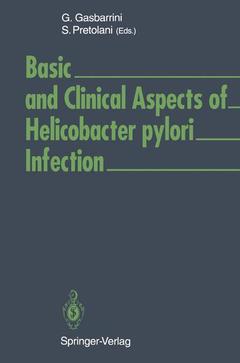Basic and Clinical Aspects of Helicobacter pylori Infection, Softcover reprint of the original 1st ed. 1994
Langue : Anglais
Coordonnateurs : Gasbarrini Giovanni, Pretolani Stefano

A century ago the Italian pathologist Bizzozero described the relationships between spiral bacteria and the mammalian gastro intestinal tract. Since 1982, when Helicobacter pylori was discovered, gastroduodenal disease have been completely revised as a con sequence of the results of basic and clinical research in this field. Progress in understanding the pathogenesis of this bacterium has been made by studying H. pylori infection in animal models. More specific diagnostic tools have been developed using new molecular biology techniques. Future trends are directed towards preparing a specific H. pylori vaccine. A new classification for gastritis, the Sydney System, including H. pylori gastritis, was proposed in 1990. As concerns the clinical approach to peptic ulcer disease in the 1990's, the majority of authors agree on the importance of H. pylori eradication. Moreover, recent clinical studies suggest that H. pylori infection can be associated with other gastroduodenal diseases, such as non ulcer dyspepsia and gastric cancer. Multicenter trials to standardize serological methods and evaluate the efficacy of new antimicrobial therapy schedules are planned throughout different European countries. The fourth Workshop of the European Helicobacter Pylori Study Group was held in Bologna, Italy, in November 1991. Two years before Bologna University celebrated its ninth centennial, giving evidence of being the oldest University in the modern world. Thus the H. pylori story that has continued for more than a century has been discussed once again at the University with the oldest tradition in the world.
Nonulcer Dyspepsia.- Nonulcer Dyspepsia.- Nonulcer Dyspepsia: Psychological Considerations.- Nonulcer Dyspepsia and Helicobacter pylori: Effect of Eradication on Symptoms and Gastritis.- Upper Gastrointestinal Endoscopy and the Prevalence of Helicobacter pylori Infection in Recurrent Abdominal Pain of Childhood.- The Value of Serodiagnosis of Helicobacter pylori in Predicting Negative Gastroscopy.- The Icelandic Nonulcer Dyspepsia/Helicobacter pylori Study: Symptomatic Response and Eradication Rate with De-Nol or De-Nol Plus Metronidazol in Treatment of Helicobacter-Positive Patients with Nonulcer Dyspepsia.- Long-Term Follow-up of Children with Helicobacter pylori-Associated Nonulcer Dyspepsia After Eradication of the Infection.- Helicobacter pylori, Surgery, and Aging.- The Role of Ulcer Surgery Today.- Effect of Single-Shot Antibiotic Treatment on Helicobacter pylori in Patients Undergoing Ulcer Operation.- The Aging Stomach.- Pathogenic Mechanisms of Helcobacter pylori Infection: Virulence.- Construction of a Molecular Population GeneticFramework for the Characterization ofHelicobacter pylori Pathogenesis by Multilocus Enzyme Electrophoresis.- The Flagella of Helicobacter pylori: Molecular Analysis and Potential in Pathogenesis.- Identification of Potential S Layer Proteins of Helicobacter pylori.- Urease as a Colonisation Factor in Helicobacter.- Affinity and Ion Exchange Chromatography in the Purification and Characterization ofHelicobacter pylori Cytotoxin-Associated Proteins.- Neutralization of the Vacuolating Toxin from Helicobacter pylori by Antisera from Patients with Duodenal or Gastric Ulcer.- Helicobacter pylori: PhosphoHpase C and Haemolysis.- Haemaglutinins ofHelicobacter pylori and Adherence to HEp-2 Cells.- Partial Purification and Characterization of Sialic Acid Specific Soluble Haemagglutinin(s) of Helicobacter pylori Strain NCTC 11637.- Pathogenic Mechanisms of Helicobacter pylori Infection: Host Response.- The Role of Helicobacter pylori Gastritis in Ulcerogenesis and Carcinogenesis.- Isolation and Phenotypical Characterization of T-Lymphocytes Isolated from the Gastric Mucosa of Patients With and Without Helicobacter pylori.- Demonstration of the Major Cytotoxin-Association Protein of Helicobacter pylori in Gastric Biopsies by Western Blotting.- Gastric Functions and Helicobacter pylori Infection in Patients with Fundic Atrophic Gastritis.- Peptic Ulcer in the Elderly: Not a Helicobacter-RelatedCondition?.- Serology of Helicobacter pylori Infection.- The Use of Helicobacter pylori Serology in Diagnosis and Treatment Monitoring.- The Use of Serological Detection of Helicobacter pylori in Epidemiology.- Helicobacter pylori Serology: Kit Evaluation and Comparison.- Standards for Serologic Study of Infection with Helicobacter pylori.- Helicobacter pylori Antigenic Preparations.- The Value of Class and Subclass ELISAs and Antibody Specificity in Monitoring Treatment of Helicobacter pylori.- Future Prospects for Helicobacter pylori Serology.- TheHelicobacter pylori San Marinq Study: Seroepidemiology of Helicobacter pylori Infection in the Republic of San Marino.- Molecular Biology of Helicobacter pylori.- Construction of Isogenic Mutants of Helicobacter pylori Deficient in Urease Activity.- Cloning of a Helicobacter pylori Flagellin Gene and Construction of a Nonflagellated Mutant by Transformation-Mediated Allelic Exchange.- Identification and Characterization of an Adhesion Gene of Helicobacter pylori by Cloning.- Molecular Cloning and Nucleotide Sequence Determination of htrA, a Gene Encoding a 48-kDa Stress Protein of Helicobacter pylori.- Diagnosis of Helicobacter pylori in Gastric Juice Aspirates Using Polymerase Chain Reaction.- Molecular Fingerprinting of Helicobacter pylori: An Evaluation of Methods.- Developments in Ribotyping of Helicobacter pylori.- The 130-kDa Vacuolating Cytotoxin-Associated Protein Is a Component of Cytotoxic Helicobacter pylori Organisms.- The Cloning and Partial Sequence Analysis of the Catalase Gene of Helicobacter pylori.- Binding of Helicobacter pylori to Extracellular Matrix Proteins.- Therapeutic Approaches.- Helicobacter pylori: Clinical Aspects.- H2 Receptor Antagonists: Is There a Place in the Treatment of Helicobacter pylori Infection?.- Proton Pump Inhibitors in the Management of Helicobacter pylori-Related Diseases.- Pharmacology of Bismuth-Containing Medicines Used to Treat Helicobacter pylori Infections.- Bismuth and Helicobacter pylori.- Antibiotics in Helicobacter pylori Treatment.- Clinical Application of Antibiotics in Eradicating Helicobacter pylori.- Cytoprotective Drugs and Helicobacter pylori Infection.- Approaches to the Treatment of Helicobacter pylori Infection.
Date de parution : 01-2012
Ouvrage de 313 p.
15.5x23.5 cm
Disponible chez l'éditeur (délai d'approvisionnement : 15 jours).
Prix indicatif 105,49 €
Ajouter au panierThème de Basic and Clinical Aspects of Helicobacter pylori Infection :
© 2024 LAVOISIER S.A.S.



